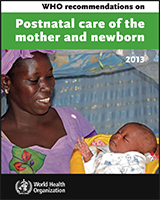Overview
The postnatal period is a critical phase in the lives of mothers and newborn babies. Most maternal and infant deaths occur during this time. Yet, this is the most neglected period for the provision of quality care. WHO guidelines on postnatal care have been recently updated based on all available evidence. The guidelines focus on postnatal care of mothers and newborns in resource-limited settings in low- and middle-income countries.
The guidelines address timing, number and place of postnatal contacts, and content of postnatal care for all mothers and babies during the six weeks after birth. The primary audience for these guidelines is health professionals who are responsible for providing postnatal care to women and newborns, primarily in areas where resources are limited. The guidelines are also expected to be used by policy-makers and managers of maternal and child health programmes, health facilities, and teaching institutions to set up and maintain maternity and newborn care services.
The information in these guidelines is expected to be included in job aids and tools for both pre- and in-service training of health professionals to improve their knowledge, skills and performance in postnatal care. These recommendations will be regularly updated as more evidence is collated and analysed on a continuous basis, with major reviews and updates at least every five years. The next major update will be considered in 2018 under the oversight of the WHO Guidelines Review Committee.
The designations employed and the presentation of the material in this publication do not imply the expression of any opinion whatsoever on the part of the World Health Organization concerning the legal status of any country, territory, city or area or of its authorities, or concerning the delimitation of its frontiers or boundaries. Dotted lines on maps represent approximate border lines for which there may not yet be full agreement.
The mention of specific companies or of certain manufacturers' products does not imply that they are endorsed or recommended by the World Health Organization in preference to others of a similar nature that are not mentioned. Errors and omissions excepted, the names of proprietary products are distinguished by initial capital letters.
All reasonable precautions have been taken by the World Health Organization to verify the information contained in this publication. However, the published material is being distributed without warranty of any kind, either expressed or implied. The responsibility for the interpretation and use of the material lies with the reader. In no event shall the World Health Organization be liable for damages arising from its use.

